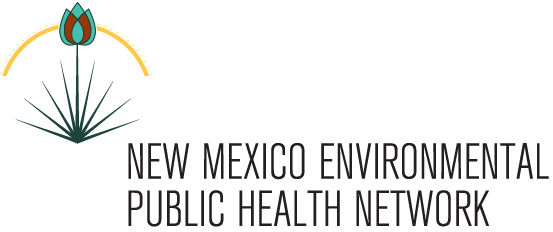May 26, 2021 –
Thanks to all of you who have been working hard on environmental public health issues in New Mexico communities and at the 2021 New Mexico legislative session.
This special edition of the newsletter features articles by two NMPEHN advisory committee members – Cara Lynch and Allyson Beasley. Both authors are young attorneys here in New Mexico who work on environmental public health policy in our state. We are pleased that young lawyers such as these two who focus on environmental issues are choosing to stay and practice in our state.
PFAS/PFOS Update
By Cara Lynch, NMEPHN Advisory Committee Member
 A lot is happening for so many of us New Mexicans right now as we battle the coronavirus and struggle to keep our jobs and families safe. That’s why it was such a relief while researching the current status of PFAS contamination in our state to come across the following video by Laura Paskus about why, especially now, we should care about PFAS contamination in New Mexico:
A lot is happening for so many of us New Mexicans right now as we battle the coronavirus and struggle to keep our jobs and families safe. That’s why it was such a relief while researching the current status of PFAS contamination in our state to come across the following video by Laura Paskus about why, especially now, we should care about PFAS contamination in New Mexico:
Perfluoroalkyl and polyfluoroalkyl substances (PFAS) are a group of man-made chemicals that have been used for a large number of purposes since the 1950s. PFAS have been used in food packaging, cleaning products, stain-resistant carpet treatments, nonstick cookware, and firefighting foam, among other products, including in publicly available herbicides and pesticides. Because PFAS bioaccumulate over time, meaning they stay present in our bodies for long periods of time, and because of their ubiquitous presence in many of our everyday products, health scientists are sounding the alarm about the links between exposure to PFAS and health effects.
There are thousands of PFAS chemical variants. This makes it especially challenging for health scientists to prove direct causes of health effects of PFAS. However, to date scientists have found possible links between human exposure to PFAS and health outcomes. These health effects include: altered metabolism, fertility, reduced fetal growth and increased risk of being overweight or obese, and reduced ability of the immune system to fight infections. So, while our collective efforts are focused on fighting COVID, it’s clear that exposure to PFAS compromises the body’s ability to fight off infection and therefore, presents the possibility of exacerbating factors of comorbidity.
One of the greatest concerns in New Mexico for PFAS contamination is pollution of our groundwaters. In 2018, the US Department of Defense notified the State that PFAS were discovered in groundwater at and around Cannon Air Force Base and Holloman Air Force Base. Starting in the 1970’s and since the Air Force uses a firefighting foam containing PFAS-based retardants. On March 12, 2020, the Pentagon also released an updated list containing 651 sites nationally that contained PFAS contamination. The list included four additional sites in New Mexico: the Army National Guard armories in Rio Rancho and Roswell, the Army Aviation Support Facility in Santa Fe, and White Sands Missile Range.
New Mexico’s Environment Department (NMED) and our Attorney General have taken strong, proactive steps to protect our groundwater from further contamination, including demanding the Department of Defense clean-up the contamination. Right now, the State’s claims against the Air Force are being heard in federal court. In the meantime, NMED and the NM Department of Health are monitoring our state’s drinking water systems for PFAS contamination. In addition, residents who believe their water wells might be contaminated—based upon proximity to a DOD site where PFAS has been found in groundwater—can contact NM DOH to have their water tested: New Mexico Department of Health at 505-827-0006.
For comprehensive coverage on PFAS contamination of New Mexico’s waters, please follow this interactive website published by PBS New Mexico: https://www.newmexicopbs.org/productions/groundwater-war/timeline/.
If you want to learn more and take action on PFAS regulation, here are some helpful links with information about strengthening state and federal regulation of PFAS, including creating stronger safe drinking water standards and testing our foods for PFAS chemical levels:
https://www.nrdc.org/protect-people-toxic-pfas-chemicals
https://www.edf.org/health/pfas-food
https://www.sierraclub.org/michigan/pfas
https://www.jurist.org/commentary/2021/02/traven-pyles-pfas-regulation/#
A New Federal Environmental Justice Mapping and Data Tool: Challenges and Opportunities
By Allyson Beasley, Western Environmental Law Center
 President Biden’s January 27, 2021 “Executive Order on Tackling the Climate Crisis at Home and Abroad” (EO 14008) explicitly recognizes the inexorable links among climate, health, and environmental justice (which includes social and economic justice), and the corresponding need to address all of them in concert, with a whole-of-government approach. It creates a government-wide “Justice40 Initiative” with the goal that “40 percent of the overall benefits of relevant federal investments” go-to “disadvantaged communities,” and tracks performance toward that goal through the establishment of an Environmental Justice Scorecard. The order also directs the Council on Environmental Quality (CEQ) to create a geospatial Climate and Economic Justice Screening Tool by, roughly, the end of July or beginning of August (within 6 months of the issuance of the Executive Order), and to annually publish interactive maps “highlighting disadvantaged communities.” This new tool will build on an existing geospatial environmental justice mapping tool, EPA’s “EJ Screen,” in order to “identify disadvantaged communities, support the Justice40 Initiative, and inform equitable decision making across the federal government.”
President Biden’s January 27, 2021 “Executive Order on Tackling the Climate Crisis at Home and Abroad” (EO 14008) explicitly recognizes the inexorable links among climate, health, and environmental justice (which includes social and economic justice), and the corresponding need to address all of them in concert, with a whole-of-government approach. It creates a government-wide “Justice40 Initiative” with the goal that “40 percent of the overall benefits of relevant federal investments” go-to “disadvantaged communities,” and tracks performance toward that goal through the establishment of an Environmental Justice Scorecard. The order also directs the Council on Environmental Quality (CEQ) to create a geospatial Climate and Economic Justice Screening Tool by, roughly, the end of July or beginning of August (within 6 months of the issuance of the Executive Order), and to annually publish interactive maps “highlighting disadvantaged communities.” This new tool will build on an existing geospatial environmental justice mapping tool, EPA’s “EJ Screen,” in order to “identify disadvantaged communities, support the Justice40 Initiative, and inform equitable decision making across the federal government.”
Just one day after Biden issued the Executive Order, Senators Ed Markey, and Tammy Duckworth and Congresswoman Cori Bush introduced a related bill: the EJ Mapping and Data Collection Act of 2021. If passed and signed into law, the bill would create an interagency environmental justice mapping committee, led by the Environmental Protection Agency, “to identify criteria, find data gaps, create a data repository, and work with communities to create an interactive mapping tool based on cumulative impacts to locate environmental justice communities.” The bill also directs the mapping committee to “consult” with an advisory council, at least half of which will be “representatives and members of communities harmed by environmental injustices,” chaired by an environmental justice advocate.
Early and ongoing consultation and collaboration should be integral to the development of a new EJ mapping and data tool, regardless of whether the Mapping and Data Collection Act passes. It is critical to the effectiveness of this tool—and to the just and equitable decision-making “process” component of environmental justice—that it be designed and developed through equitable partnerships and true collaboration (not just after-the-fact “input” or a mere “right to be involved”) with frontline and fenceline community members and community-based advocates and groups.
We don’t yet know much about avenues for such participation, outside of the advisory council that would be formed as part of the Environmental Justice Mapping and Data Collection Act. Nor do we yet know what, precisely, the new tool will entail. However, we can glean some insights—including some caveats—from EPA’s existing geospatial tool, EJ Screen, on which the new tool will build.
The current version of EJ Screen attempts to encapsulate the relationship between environmental hazards and underlying social and structural factors through the use of Environmental Justice (EJ) Indexes.” These “EJ Indexes” combine eleven “environmental” indicators—such as Ozone and PM2.5 concentrations or proximity to hazardous waste sites—with six “demographic” indicators that, in EPA’s view, are “very general indicators of a community’s potential susceptibility to the types of environmental factors included in this screening tool.” These “demographic indicators” include the percentages of people in a particular block group who are “low-income,” “people of color,” “under age 5,” “over 65,” “linguistically isolated,” or have “less than high school education” (with specific definitions for each of these categories). The “EJ Index” for a particular geographic area—typically either a census block group or a “buffer” area of up to 10 miles around a specific point, such as an oil refinery or a school or residence—can then be compared, using percentiles, to EJ Index values for a state, EPA region, or the U.S. overall. In its current form, EJ Screen does not expressly factor in climate-related risks or impacts. However, updates to EJ Screen that have already been proposed do include climate factors such as flooding—rightly recognizing that health and environmental justice cannot be extricated from conversations about—or actions to address–climate change.
To date, advocates have used EJ Screen data in comments to federal agencies on agencies’ Environmental Assessments or Environmental Impact Statements required under the National Environmental Policy Act (NEPA)—pointing out the inadequacies in the agencies’ environmental justice analyses (or the absence of an environmental justice analysis altogether) and using EJ Screen data to show that there are, in fact, people and communities likely to be disproportionately affected by a proposed project. And recently, a Louisiana judge required Louisiana’s Department of Environmental Quality to take a second look at its air permit for a petrochemical complex that would be located in a predominantly black community along a stretch of the Mississippi River known as “cancer alley”—a decision based in part on EJ Screen data demonstrating elevated cancer risks among residents in the area. However, agencies have also used EJ Screen as a shield in defending their environmental justice analyses, or lack thereof, from administrative protests and legal challenges, arguing that an EJ Screen analysis ruled out environmental justice concerns in a particular community or project area.
Environmental justice experts have said that EJ Screen data is not granular enough to reflect environmental justice issues in smaller communities. And, as EPA itself has pointed out, EJ Screen “is not used by EPA staff” to identify or label an area as an “EJ Community,” to quantify specific risk values in a particular location, to measure cumulative impacts of multiple environmental factors, or as a basis for agency decision-making or determining whether there are EJ concerns for a particular project or decision. Indeed, as stated in the proposed Environmental Justice Mapping and Data Collection Act of 2021, there is currently no comprehensive, nationally consistent method “to identify environmental justice communities based on the cumulative effects of socioeconomic factors, pollution burden, and public health,” and there is a “lack of nationwide high-quality data relating to environmental justice concerns, such as socioeconomic factors, air pollution, water pollution, soil pollution, and public health, and a failure to update the existing data with adequate frequency.” The current EJ Screen tool has also been critiqued as difficult to use, infrequently updated, and inadequate to capture more localized and nuanced experiences of environmental injustices and disproportionate risks and impacts.
A new tool such as the one proposed in Biden’s January 27, 2021 Executive Order and in the Environmental Justice Mapping and Data Collection Act could help fill some of these gaps. It can—and indeed, must—be shaped by the knowledge, expertise, priorities, and lived experiences of those in frontline and fenceline communities, and developed and implemented with free prior and informed consent. It could help build out the kinds of quantitative and spatial assessments that can be highly persuasive to policymakers, agency decision-makers, and judges—particularly if it can help illuminate cumulative risks and impacts, and any causal links between particular “exposures” and “outcomes.” As proposed in the Environmental Justice Mapping and Data Collection Act, a new tool could not only help federal agencies in “screening Federal policies, permitting processes, and investments for environmental and climate justice impacts,” but also, could include a means for communities to self-identify as “environmental justice communities” for inclusion in the tool, “which may include citing qualitative data on conditions for which quantitative data are lacking.” A new tool could also help illustrate the scope of inequities in environmental and climate-related exposures, risks, and health outcomes to the general public in a more accessible and interactive way—and thus, ideally, can help galvanize advocacy and action.
That said, one tool or associated Initiative is certainly not a panacea. Geospatial data coupled with quantitative indexes of risks and impacts—even cumulative ones—can not fully capture all of the ways people and communities experience inequities and injustices. For one, “environmental,” “health,” and “climate” risks and impacts, and underlying “demographic” “social” or “socioeconomic” factors, are not so easily compartmentalized or so neatly tallied up as any quantitative assessment may indicate (although these complexities should not be exploited as a reason to avoid environmental justice analyses altogether). Nor is a mapping or screening tool, on its own, able to capture the fact that these inequities and injustices are not neutral or randomly distributed, but instead result from unjust structures and systems. And of course, the tool alone will not illustrate how people and communities are also building power to dismantle these unjust structures and systems.
But perhaps map layers and data from the tool could be applied to help trace certain risks and outcomes in a particular area not only to specific pollution sources, but also to particular policies and practices such as redlining or gerrymandering. And the tool could, ideally, be used to help illuminate and advocate for the potential benefits of a particular decision, action, or policy change in frontline and fenceline communities in the future as well—to illustrate not only what is and what has been—but also what could be, according to people and communities who understand the impacts firsthand.
UPCOMING EVENTS
 Many of you attended New Mexico First’s 2020 Health Town Hall, including community conversations, attendance at the town hall, and continued implementation work. Town Hall participants identified 18 recommendations and multiple strategies for systems and policy change to strengthen health, body, mind, and spirit.
Many of you attended New Mexico First’s 2020 Health Town Hall, including community conversations, attendance at the town hall, and continued implementation work. Town Hall participants identified 18 recommendations and multiple strategies for systems and policy change to strengthen health, body, mind, and spirit.
New Mexico First is now convening a Health Mini-Forum Series to prioritize recommendations, with a focus on policy and systems change efforts with an appropriation focus. For more information, see:
https://nmfirst.org/town-halls/health-mini-forum-series/
 The National Association of State Departments of Agriculture (NASDA) Foundation is working with the United States Department of Agriculture, Agricultural Marketing Service to provide educational and technical assistance for black, indigenous, and people of color and underserved groups wishing to apply for the Local Agriculture Marketing Program (LAMP) grants. NASDA will host two webinars Wednesday, May 26, to provide resources and information on how to apply. The webinar at 9 a.m. MT will focus on the Farmers’ Market Promotion Program (FMPP), and the webinar at 2 p.m. MT will focus on the Local Food Promotion Program (LFPP). Everyone is welcome to attend. LAMP Grant Informational Webinar Registration Click below to register for an upcoming session:
The National Association of State Departments of Agriculture (NASDA) Foundation is working with the United States Department of Agriculture, Agricultural Marketing Service to provide educational and technical assistance for black, indigenous, and people of color and underserved groups wishing to apply for the Local Agriculture Marketing Program (LAMP) grants. NASDA will host two webinars Wednesday, May 26, to provide resources and information on how to apply. The webinar at 9 a.m. MT will focus on the Farmers’ Market Promotion Program (FMPP), and the webinar at 2 p.m. MT will focus on the Local Food Promotion Program (LFPP). Everyone is welcome to attend. LAMP Grant Informational Webinar Registration Click below to register for an upcoming session:
May 26 at 11a.m. https://zoom.us/meeting/register/tJckd-mvqDstE9UKBAeYSEjuiDKnJDna_roC
May 26 at 4 p.m. https://zoom.us/meeting/register/tJ0ofuysqD4qEtR1gLdbLMevQ7Y1kkjiqfUF
For applicants interested and to check for eligibility, more information can be found at https://www.ams.usda.gov/services/grants/lfpp. The deadline for this application is June 21, 2021, at 11:59 p.m. EDT. FMPP’s purpose is to support the development, coordination, and expansion of direct producer-to-consumer markets to increase access to and availability of locally and regionally produced agricultural products. For applicants interested and to check eligibility, more information can be found at https://www.ams.usda.gov/services/grants/fmpp.




